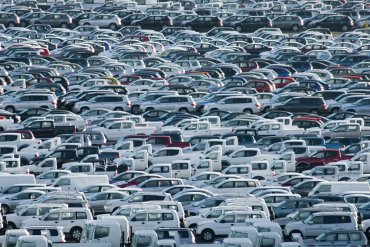
Australian lubricant suppliers are unusually buoyant these days, talking about a pick-up in sales and demand in a market thats been in the doldrums for several years.
We seem to be moving ahead. Were increasing our volumes, said Greig Herden, technical manager at Hi-Tec Oils, a blender based in Smithfield, New South Wales. Everyone I talk to seems to be, too.

Photo: BMCL/Shutterstock
Imported vehicles crowd a shipping dockyard in Sydney. Vehicle sales in Australia are rising.
Its a big deal to hear reports of an uptick in the lubricant business in Australia, as its been ranked among the worlds 20 biggest markets. Market research firm IBISWorld earlier this year estimated the Australian lubricant and grease market to turn over revenue of some $2 billion a year.
Just two years ago a 30 percent drop in capital expenditure in the mining industry – one of the domestic economys biggest drivers – underscored the gloom. Early signs of a blossoming in manufacturing started to emerge last year, and now mining is picking up, passenger car sales are growing, the transport sector is healthy, and infrastructure projects are raising demand for lubricants and greases used in big equipment.
Fuchs Lubricants Australasia Managing Director Wayne Hoiles also sees some signs of improvement.
Theres definitely an upside in the mining sector, he said, noting record mine production in recent quarters. Australian sales of mining lubricants, including dragline, gear and transmission oils, are estimated to be approximately 400 million Australian dollars a year, according to a 2017 report by Frost & Sullivan, a United States-based market research firm.
The other sectors are moving up and down, said Hoiles. The passenger car market is quite strong. The transport sector is doing well, but the agricultural sector is affected by drought. Its a patchwork.
Drought grips much of the country. Queensland and New South Wales are big farm states, and 60 percent of the former and 100 percent of the latter are now under drought declaration. Farmers are calling it the worst drought in living memory.
Fuchs is demonstrating its confidence in the broader market by spending money to expand its Australian production facilities. Earlier this year it opened a new plant and lab 150 kilometers north of Sydney to replace a smaller, older nearby facility and to better service its big mining and transport clients. Now its upgrading its Melbourne grease plant.
Fuchs, is one of the five biggest lube suppliers in Australia, after BP, Caltex, Valvoline and Viva Energy. Together those companies hold more than 70 percent of the market, according to a 2018 IBISWorld research report.
Another sign of optimism is the wave of new entrants. Malaysias Petronas and Chinas Sinopec are among offshore suppliers to have made footholds. The Australian market consumes relatively high quality lubricants, which are demanded to service modern and sophisticated equipment.
Its very competitive. Theres probably 100 to 140 different oil brands in Australia, said Mike Ridley-Smith, who last year started importing Gulf Oil lubricants. He and another an ex-Caltex Australia executive, Phil Ames, signed a deal with Gulf Oil to distribute about 70 products, targeting the niche segment of luxury vehicles, motor sport and classic car enthusiasts.
In the initial phase we are selling high-end motor oils, said Ridley-Smith, adding, We target independent motor vehicle workshops that service European prestige brands – Porsche, Mercedes, BMW. They also service workshops preparing vehicles for the racetrack, including vehicles going out for show or to parade.
We have ambitions down the track to get into other markets.
Macroeconomic data backs up the anecdotal reports of an improved market. Australias most recent measure of gross domestic product showed a 3.1 percent expansion that extended a record of almost 26 years of growth unbroken by recession.
Meanwhile, the nations population hit 25 million this month, a decade earlier than previously forecast. More people translates into higher demand for vehicles and lubricants.
Truck and car sales are breaking records. The Federal Governments Ministry for Infrastructure and Transport predicted that the countrys freight demands will grow by almost 50 percent by 2030.
National truck sales data from the Truck Industry Council showed a record month in June of 4,251 units (including vehicles ranging from prime movers to light trucks) and a 21 percent increase for the year ending July.
New vehicle sales reached a record of more than 605,000 in the first half of this year, outstripping sales in the same period a year earlier by 1 percent. Industry attributed the increase to low interest rates, luxury vehicle tax breaks and a competitive new car market.
The number of vehicles in the country is up more than 2 percent this year to 19.2 million, according to a national government tally of registered vehicles. Diesel-powered vehicles constituted almost one-quarter of that, up from about 17 percent just five years earlier.
The shift to diesel created increased demand for higher performance engine oils to manage heavier soot levels than those required for gasoline-powered vehicles.
Theres enough market for us to get a share, said Ridley-Smith. The car parc in Australia is gradually skewing towards prestige brands. We are a very wealthy country, and we are buying a lot of high-end cars. Australians seem to go for the larger engines.